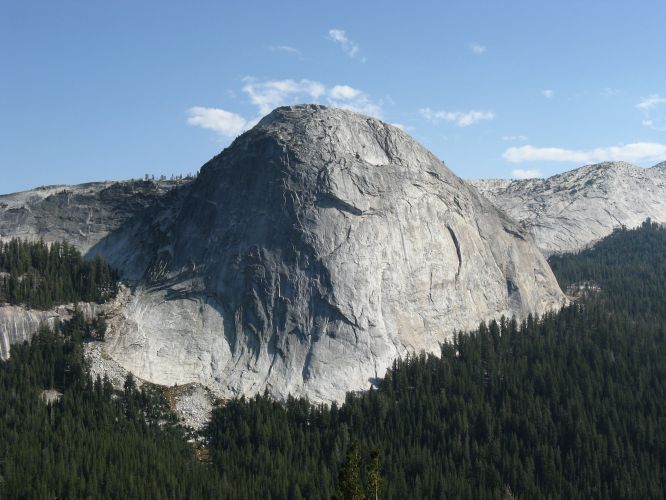Routes: Regular Route (II, 5.9)

|
|
Fairview Dome is a very impressive formation that is hard to appreciate except from the
summit of Daff Dome across the highway. Its north face features the Regular Route, first
climbed (mostly with aid) by Reed and Pratt in 1958, and since featured in 50 Classic
Climbs of North America (with a rating of III 5.9; most modern parties would rate
it II 5.9). It has become a fashionable überclassic and hence
often is crowded. The south side of Fairview is surprisingly mellow and offers a mostly
second class friction walkoff.
Routes: Regular Route (II, 5.9)
|
|
|
References:
supertopo.com
|
||
Date: August 29, 2009
Party: Paul and Dietrich Belitz
Route: Regular Route
Equipment: 60m rope, cams 0.2 to 0.4, triple cams 0.5 to 2, double cams 3, double set of stoppers
Time: 6 hours 50 mins (on the route)
Comments: We spent almost 2 hours waiting in line at the base. Allow 20 minutes for the approach, and 40 minutes for the descent.
Trip report:
We got up at 6am and were at the trailhead at 7, only to find one car in the pullout and another party ready to leave their truck. By 7:30 we were at the base of the climb, and while we waited for the two parties ahead of us to gain some elevation a whole bunch of additional parties showed up, took their number, and lounged on the slabs. Fortunately, all parties seemed to be of roughly equal ability, and once we got going at 9:30 we did not run into anybody past the first belay, and nobody ran into us.
Paul took the first pitch and belayed at the tree, which gives a few feet of rope to spare with a 60m. The middle of the pitch was wet, with water oozing out of the crack all over the place. I got my left shoe wet, which caused me to slip and almost fall at one point, but apart from that it was not too bad. In dry conditions we would have cruised it.
I led the second pitch (the 5.8 offwidth pod), and found to my pleasant surprise that it protects easily: a good cam just below the pod, a good cam just above it, no problem. After reaching the ledge that is just 30 or 40' above the tree I contemplated whether I should get going, but then we decided to belay from ledge to ledge, as that would be more comfortable than hanging belays. So Paul got another long pitch, the 5.8 finger crack. The supertopo calls it "incredibly sustained", which is a fair characterization. It also says it's 205' long, which is a bit pessimistic; it turned out that undoing the anchor tie-in (staying tied in just with my daisy chain) sufficed to get Paul to the ledge above the overhang; no simul-climbing was necessary. Even while following I got somewhat out of breath, but we both managed the long pitch without hanging.
The next pitch was mine. I watched the party ahead of us for a while, who went left after the white flake and pulled an overhang, which gave the second some trouble. This looked implausible to me, and I vowed to go right after the flake. Indeed, after the 5.8 move to get onto the flake an easy ascending traverse brought me to Crescent Ledge, which is very wide and comfortable. I can believe that Pratt and Reed spent a comfortable night here.
Paul led the fifth pitch via the Hollow Flake Variation (5.easy, no pro), then I tackled the sixth pitch that starts on the ever increasing slope of the ledge. Soon I was forced onto flakes that stick out from the wall, using the crack only for protection, and some exciting moves brought me under the 3' roof. Here I made the only mistake on the entire climb: I went around the roof on the right alright, but failed to go back left into the correct dihedral and instead climbed a dirty, grassy dihedral just to the right that offers no meaningful pro and peters out after 25 or so feet. By the time I realized my mistake I was 12 feet above my last piece on terrain that I did not really want to downclimb. I set an anchor using a rather suspect flake (it seemed okay for downward pull, but moved when pushed upward) and instructed Paul to fall really gently if he should feel the urge to take a fall. He followed to the roof bypass, then took the correct dihedral and belayed me from above. This let me traverse via 5.9 face moves back over to the route while risking only a managable pendulum fall.
This had been the last truly technical pitch. A long horizontal traverse followed by easy climbing on blocks brought me to a tree, then Paul led another pitch past a second tree. From there on the route became ill-defined, and we just kept going straight up, not necessarily taking the line of least resistance. One final pull past a short headwall got us to the summit and breathtaking views. The route had taken us just under 7 hours, not bad considering that neither one of us had done any climbing on real rock since May.
The descent down the south side, is very mellow, mostly second class friction. We contoured around the dome back to the start of the route to retrieve our sneakers, and then strolled back down to our car. A great route well deserving its classic status!